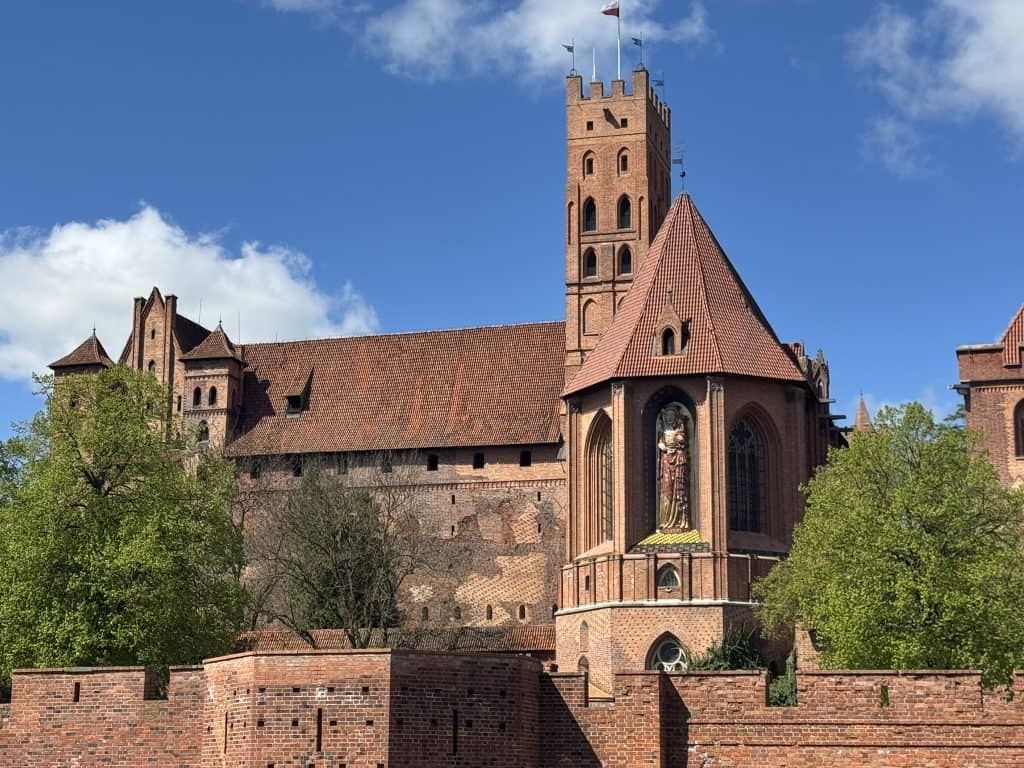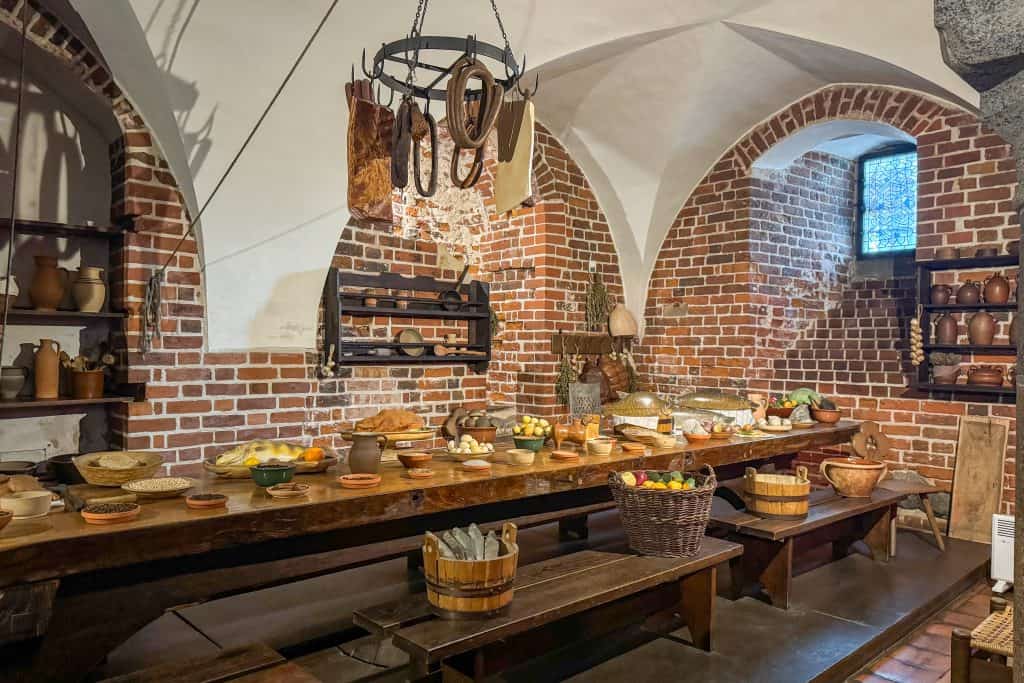Malbork Castle from Gdańsk: How to Plan the Perfect Day Trip
Freedom Years Travel contains affiliate links. If you make a purchase using one of the links below, we may receive compensation at no extra cost to you. We only recommend products and services we use and trust. Read our disclaimer for more information.
If you’re spending time in Gdańsk and looking for an easy and rewarding day trip, Malbork Castle should be at the top of your list. Just 45 minutes away by train, this enormous medieval fortress offers an unforgettable glimpse into the power struggles, legends, and craftsmanship of medieval Poland—and it’s surprisingly simple to visit independently.
In this guide, I’ll walk you through how to get to Malbork Castle from Gdańsk, how to book your tickets, what to expect during your visit, and why it’s absolutely worth your time. And if you’re still finalising your plans in the city, you might also want to check out my Gdańsk guide before heading further afield.
Why Visit Malbork Castle?
Malbork Castle is a UNESCO World Heritage Site, the largest brick castle in the world, and one of the most visually striking medieval fortresses in Europe. Built by the Teutonic Knights, it played a pivotal role in shaping the history of Central Europe. As you walk through its vast courtyards and grand halls, it’s hard not to feel like you’ve stepped onto the set of one of the Netflix-style medieval epics—and it’s all just an easy day trip from Gdańsk.
A Brief History of Malbork Castle
Walking through Malbork Castle, it’s easy to forget you’re in modern Poland. This 13th-century fortress was built by the Teutonic Knights, a Catholic order originally from Germany, who were invited here to convert the local pagan population. But things quickly got out of hand. The knights didn’t just spread religion—they became a powerful political and economic force, controlling trade routes, monopolising the amber industry, and sometimes using force to maintain their grip – almost like a medieval mafia!
Their dominance sparked resistance. In 1410, the Battle of Grunwald saw Polish and Lithuanian forces deal the knights a crushing defeat, though Malbork itself was never taken by force. Strapped for cash, the order eventually sold the castle to the King of Poland. Several Polish kings ruled from Malbork, cementing its status as a centre of power in the region.
Suffering heavy damage during World War II, the castle has been painstakingly restored. Today, wandering its courtyards and halls, you can almost hear the clatter of armored knights and get a sense of medieval life within these walls.
⚔️ Life Inside the Teutonic Order
The Teutonic Knights were skilled horsemen, disciplined warriors, and castle managers. Trained from a young age, they mastered swordplay, horseback combat, and strict religious routines. Beyond the battlefield, they ran workshops, governed territory, and controlled the amber trade.


How to Get to Malbork Castle from Gdańsk
The most convenient way to reach Malbork Castle from Gdańsk is by train. We used the Jakdojade app to plan our journey and purchase tickets in advance. It’s intuitive and even shows platform numbers, making the process almost foolproof. Our train—an InterCity (IC) service—was clean, comfortable, and right on time.
Depending on the train service you choose, the trip from Gdańsk Główny to Malbork takes between 24 and 75 minutes. If you’re using Jakdojade, double-check the train type and duration before booking—especially if you’re timing your castle visit. If your service has the option of reserving a seat, I’d recommend it – our return trip to Gdańsk was absolutely full and we had to stand for the entire trip.
Pricing will also depend on which service you select. EIP is the premium service which is around 63PLN each way. We paid 19PLN for an IC train.

Once you arrive, it’s a pleasant 15–20 minute walk through the township to the castle grounds. Signage is minimal, but Google Maps will guide you easily—just turn right as you exit the station.
🌟Tip: Before heading out, take a peek inside the Malbork Railway Station waiting room. Its elegant design is surprisingly grand—and well worth a quick look.

🏰 Malbork Castle Essentials at a Glance
📍 Location: Malbork, northern Poland (approx. 60 km from Gdańsk)
🕒 Opening Hours:
Apr–Sep: 9:00 AM – 8:00 PM
Oct–Mar: 9:00 AM – 4:00 PM
Exhibition entry closes: 5:00 PM
Last entry (Historical Route): 4:30 PM
Last entry (Castle Grounds): 6:30 PM
🎟️ Admission:
Adults: 70 PLN (~€16 / AUD $26)
Students/Seniors: 55 PLN
Family ticket: 210 PLN (2 adults + 3 children)
Audio guide or app included with most tickets
⏱️ Visit Duration:
Allow 2–3 hours to explore the castle fully
📅 Closed: Some public holidays – check official hours
💡 Tip: Book online to skip the queues, especially in summer
Malbork Castle Tickets and Touring Options
You can buy tickets to Malbork Castle either online or at the ticket office on site. I chose the Historical Route, which includes a self-guided audio tour.
Prefer a live guide? You can book a guided tour independently through one of over 200 accredited guides. The full list is available on the castle’s official website, but bookings are arranged directly—usually by phone or email—as there’s no online checkout. A good option if you like asking questions or want a more personal experience.
Historical Route vs. Castle Grounds
Historical Route: Takes you inside the key areas of the castle—like the Grand Master’s quarters, the chapel, refectory, and ceremonial halls. It’s the most immersive option and ideal if you want the full story.
Castle Grounds Route: Covers the outer courtyards, fortifications, and defensive walls. It’s a lighter visit—better if you’re short on time or just want a scenic walk around the grounds.
👉 For a deeper experience, go with the Historical Route + audio guide—it’s the most complete and flexible way to explore the site at your own pace.
🧳 Bag Tip
Lockers are available near the entrance, but you’ll need a 2 PLN coin to use them. When we visited, there wasn’t an easy way to get change, so we just carried our bags. Worth being prepared for!
Prefer a Fully Organised Tour from Gdańsk?
If you’d rather leave the logistics to someone else, there are excellent day tours that include transport from Gdańsk, castle entry, and a professional guide. These tours are especially good if you want a relaxed, done-for-you experience.
When I visited, I accidentally booked for the wrong day—cue that heart-stopping moment where you think you’ve just lost your money. Fortunately, Poland’s excellent customer service came through, and the refund was handled quickly and smoothly. Still, a guided tour from Gdańsk can save you that kind of stress and let you focus on enjoying the castle and its remarkable history.
- From Gdańsk Malbork Castle Guided Tour with Hotel Pickup
Includes hotel pickup & return and castle entry with the audio guide.
🕒 Duration: Approx. 5-6 hours - Malbork Castle Tour from Gdańsk
Includes hotel pickup & return; castle entry and a highly rated live guide.
🕒 Duration: Approx. 4-5 hours - Malbork Castle and Westerplatte Tour with Lunch
Includes visits to both Malbork Castle and Westerplatte; audio guide at the castle and live guide at Westerplatte; a traditional lunch in the Polish countryside; HOW MANY PEOPLE
🕒 Duration: Approx. 7-8 hours
💡Tours often book out at least a month in advance, so it’s worth planning ahead.


What to Expect at Malbork Castle
You’ll want to allow at least 2–3 hours to explore the complex. Malbork Castle is the largest brick castle in the world, and its sheer scale is hard to grasp until you’re standing inside it. It’s more than just a fortress—it feels like a self-contained medieval city, with its own layers of defence, courtyards, passageways, and ceremonial spaces. The architecture alone is striking, especially when you imagine the thousands of people who once lived and worked within these walls.
There’s a fair amount of cobblestones and stair climbing involved, so comfortable shoes are a must. Despite being one of Poland’s most popular attractions, the site is so vast that it rarely feels crowded.
We opted for the audio tour, which was engaging and well-paced. It offered just the right amount of historical context without becoming too heavy. We did lose our way briefly toward the end, but there were helpful staff on hand to point us back in the right direction.
And while we visited during the day, it’s worth noting that evening tours are sometimes offered. With the castle lit up after dark, the whole place takes on a much more atmospheric—and slightly mysterious—feel.
Highlights of the Visit
There’s a lot to see, but some of the most memorable stops include:
The Amber Room
I hadn’t truly appreciated how beautiful amber could be until I saw this display. The room glows with delicate, intricately carved pieces—jewellery, religious objects, and talismans once believed to hold healing powers.
You will learn how prized amber was in medieval Europe—not just for decoration, but for its supposed healing and spiritual powers. The Teutonic Knights weren’t just collecting it; they controlled the trade with ruthless precision, using force when necessary to maintain their monopoly. Let’s just say that when it came to the amber trade, these were not chivalrous knights!
Chapel, Kitchens & Mill
The castle’s domestic spaces offer insight into daily life, from simple meals to spiritual rituals. The chapel is particularly atmospheric.
Grand Master’s Room
A stately, imposing space that reflects the power and prestige of the Teutonic Order’s leadership. It’s easy to imagine the Chapter meetings held here—formal gatherings where senior knights made decisions about military campaigns, finances, and the running of the Order’s vast territories.
Medieval Armour & Weapons
Several rooms are filled with displays of armour and weaponry from various parts of Europe.
☕Rest Stop Tip
There’s a small café inside the castle grounds where you can grab a coffee, snack, or light meal. A handy option if you need a break partway through your visit. You’ll also find quiet seating areas in a few of the courtyards, which are perfect for resting your feet or just soaking up the atmosphere between sections.

Final Thoughts: Is Malbork Castle Worth the Trip?
Absolutely. Whether you love history, admire architecture, or just want a memorable day trip from Gdańsk, Malbork Castle delivers. The visit is easy to organise, full of history and character, and the castle’s scale is unforgettable.
It’s one of the best ways to add depth to your northern Poland itinerary—and you can easily explore it on your own.
Still deciding which cities to visit in Poland? I compare Kraków, Warsaw, Gdańsk to help you choose.
Planning More Adventures in Poland?
Malbork is just one highlight—there’s so much more to explore! Whether you’re heading to Kraków, Warsaw, or the Baltic coast, you’ll find detailed guides, itineraries, and practical tips to help you plan your perfect trip.
👉 Discover more things to do and places to visit in Poland
FAQs for Visiting Malbork Castle
About 45 minutes by train or car.
Plan for 2–3 hours to see the main rooms and castle grounds.
The Historical Route explores the castle’s interiors and main rooms; the Castle Grounds Route covers courtyards, walls, and fortifications.
Yes—through the Museum Ticket Office or the Circle of Malbork Guides. Booking is by email or phone, with prices from around PLN 180 for small groups.
Absolutely. Audio guides are included with tickets and provide a detailed, self-paced experience.
Yes, the castle has many stairs. Lockers are available but require a 2 PLN coin.
Yes, tickets vary depending on the route and age, with discounts for students and seniors.
No—it was only sold by the Teutonic Knights; it was never defeated militarily.
It showcases finely crafted amber objects, used historically as amulets, religious items, and symbols of wealth and prestige.
Yes, Malbork hosts an annual Siege of the Castle reenactment each July, recreating the events after the 1410 Battle of Grunwald when Polish forces attempted to take the fortress. It includes historical performances, medieval camps, and family-friendly events.







